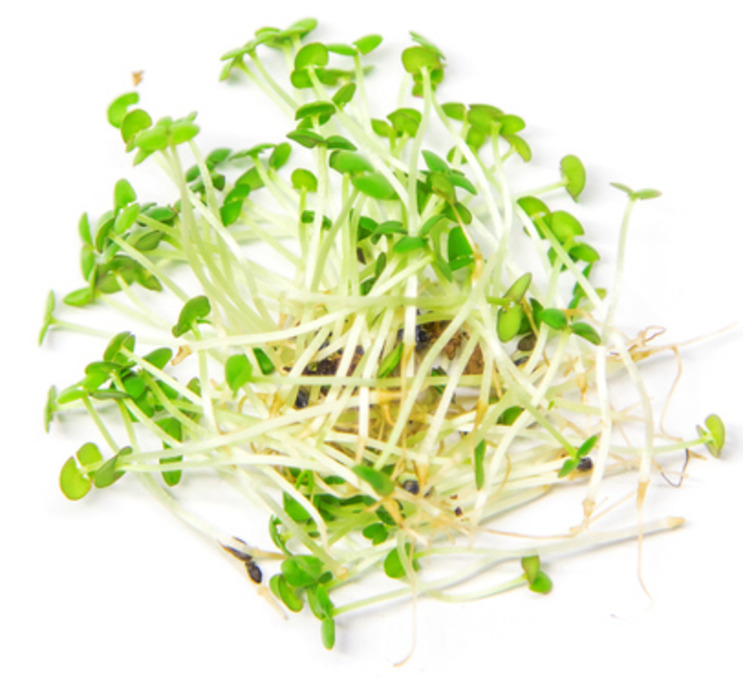Microgreens have become an increasingly popular ingredient in modern gastronomy because of their flavor, texture, and attractive appearance. Among these microgreens is basil, an aromatic and medicinal plant used for centuries in traditional cooking and medicine.
Scientific studies have found that basil microgreens contain even higher levels of antioxidants and vitamins than the mature plant. Basil microgreens are rich in essential nutrients such as:
Vitamin K: Basil microgreens are an excellent source of vitamin K, a fat-soluble vitamin essential for blood clotting and bone health.
Vitamin A: Basil microgreens are also rich in vitamin A, which is vital for vision, growth, and bone development. Vitamin A is also an antioxidant that can help prevent cell damage and protect against chronic disease.
Vitamin C: Basil microgreens are an excellent source of vitamin C, an antioxidant that helps protect cells against free radicals and enhances immune function.
Iron: Basil microgreens are high in iron. Iron is essential for red blood cell production and oxygen transport throughout the body.
Basil microgreens are known for their numerous properties:
- Antioxidants: Basil contains polyphenolic compounds such as rosmarinic acid, caffeic acid, chlorogenic acid, and flavonoids. These compounds have antioxidant properties that help prevent cell damage and oxidative stress caused by free radicals in the body. One study found that basil leaf extracts have significantly high antioxidant capacity, even in small amounts, suggesting that basil microgreens may also have significant antioxidant content.
- Anti-inflammatory: The anti-inflammatory properties of basil are mainly due to rosmarinic acid. This compound has the ability to reduce inflammation in the body by inhibiting the production of inflammatory molecules such as interleukin-1β and tumor necrosis factor-α. An animal study showed that rosmarinic acid administration significantly reduced brain inflammation.
- Antimicrobial: Basil contains essential oils with antimicrobial properties, including eugenol, estragole, linalool, ursolic acid, and oleanolic acid. These compounds may be effective in fighting bacteria, fungi, and viruses. One study found that basil extracts inhibited the growth of pathogenic bacteria such as Escherichia coli and Staphylococcus aureus.
- Digestive: Basil extracts can help relieve gastrointestinal symptoms such as indigestion and abdominal pain. Rosmarinic acid and other compounds in the plant have antispasmodic and antinociceptive properties, meaning they can reduce muscle contraction and pain associated with digestive problems. One human study found that the administration of an infusion of basil leaves reduced abdominal pain and improved digestion in patients with abdominal pain.
In conclusion, basil microgreens are a highly nutritious and healthy food. These microgreens contain antioxidant, anti-inflammatory, and antimicrobial compounds, which can help prevent chronic diseases and improve overall body health. In addition, they are an excellent source of vitamins K, A, and C, iron, calcium, and potassium, essential nutrients necessary for the proper functioning of the body. Incorporating basil microgreens into the diet can be a delicious and easy way to get specific nutrients and improve overall health.
References:
Cao, W., Hu, C., Wu, L., Xu, L., & Jiang, W. (2016). Rosmarinic acid inhibits inflammation and angiogenesis of hepatocellular carcinoma by suppression of NF-κB signaling in H22 tumor-bearing mice. Journal of Pharmacological Sciences, 132(2), 131-137. https://doi.org/10.1016/j.jphs.2016.09.003
Chaitanya, M. V. N. L., Ramanunny, A. K., Babu, M. R., Gulati, M., Vishwas, S., Singh, T. G., Chellappan, D. K., Adams, J., Dua, K., & Singh, S. K. (2022). Journey of rosmarinic acid as biomedicine to nano-biomedicine for treating cancer: Current strategies and future perspectives. Pharmaceutics, 14(11), 2401. https://doi.org/10.3390/pharmaceutics14112401
Elufioye, T. O., & Habtemariam, S. (2019). Hepatoprotective effects of rosmarinic acid: Insight into its mechanisms of action. Biomedecine & Pharmacotherapie [Biomedicine & Pharmacotherapy], 112(108600), 108600. https://doi.org/10.1016/j.biopha.2019.108600
Güez, C. M., Souza, R. O. de, Fischer, P., Leão, M. F. de M., Duarte, J. A., Boligon, A. A., Athayde, M. L., Zuravski, L., Oliveira, L. F. S. de, & Machado, M. M. (2017). Evaluation of basil extract ( Ocimum basilicum L.) on oxidative, anti-genotoxic and anti-inflammatory effects in human leukocytes cell cultures exposed to challenging agents. Brazilian Journal of Pharmaceutical Sciences, 53(1), e15098. https://doi.org/10.1590/s2175-97902017000115098
Jamshidi, N., & Cohen, M. M. (2017). The clinical efficacy and safety of Tulsi in humans: A systematic review of the literature. Evidence-Based Complementary and Alternative Medicine: ECAM, 2017, 9217567. https://doi.org/10.1155/2017/9217567
M., S., Kr, S., B., S., G., V., S., R., K., S., & K, M. (2016). Ocimum sanctum: a review on the pharmacological properties. International journal of basic and clinical pharmacology, 558-565. https://doi.org/10.18203/2319-2003.ijbcp20161491
Sadeghi, A., Bastin, A. R., Ghahremani, H., & Doustimotlagh, A. H. (2020). The effects of rosmarinic acid on oxidative stress parameters and inflammatory cytokines in lipopolysaccharide-induced peripheral blood mononuclear cells. Molecular Biology Reports, 47(5), 3557-3566. https://doi.org/10.1007/s11033-020-05447-x
Soumya, C., Priya Sugandhi, G., Aparna, K., Naik, V. R., & Sugandhi, G. P. (s. f.). Nutritional profiling of microgreens. Researchtrend.net. Recuperado 18 de mayo de 2023, de https://www.researchtrend.net/bfij/pdf/276%20Nutritional%20Profiling%20of%20Microgreens%20Ch.pdf
Szymanowska, U., Złotek, U., Karaś, M., & Baraniak, B. (2015). Anti-inflammatory and antioxidative activity of anthocyanins from purple basil leaves induced by selected abiotic elicitors. Food Chemistry, 172, 71-77. https://doi.org/10.1016/j.foodchem.2014.09.043
Disclaimer
The information provided in this article is for educational and informational purposes only and is not intended as medical advice. It is not a substitute for professional medical advice, diagnosis, or treatment. Always seek the advice of a qualified healthcare provider with any questions you may have regarding a medical condition. The author and publisher of this article are not responsible for any adverse effects or consequences resulting from the use of any suggestions, preparations, or procedures described in this article.






 Become a Reseller
Become a Reseller













